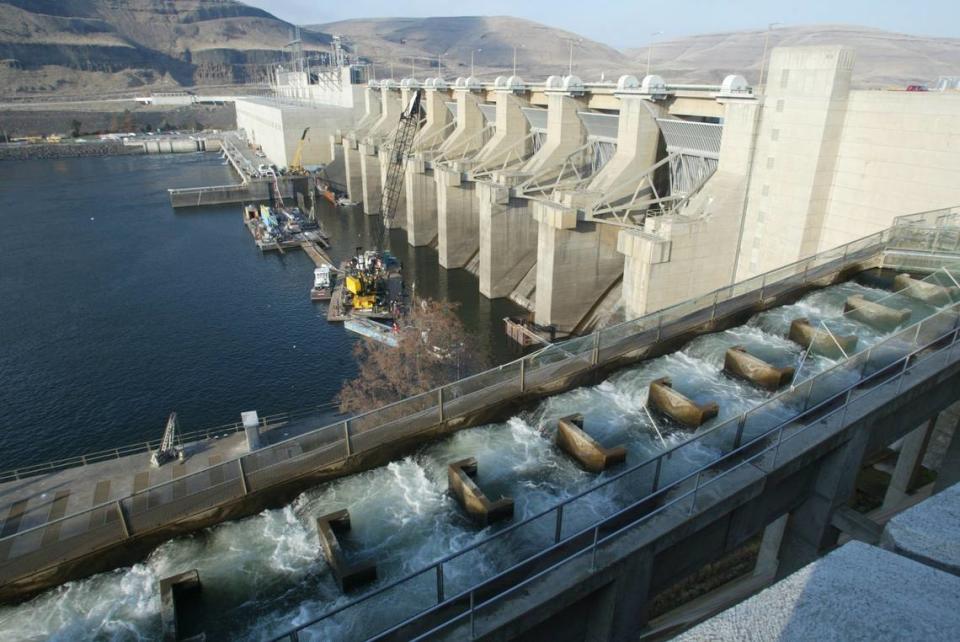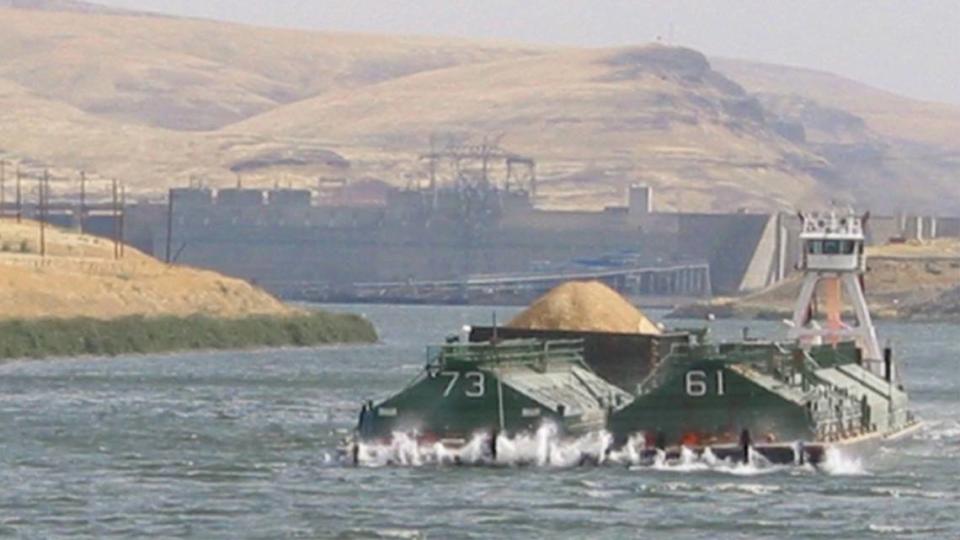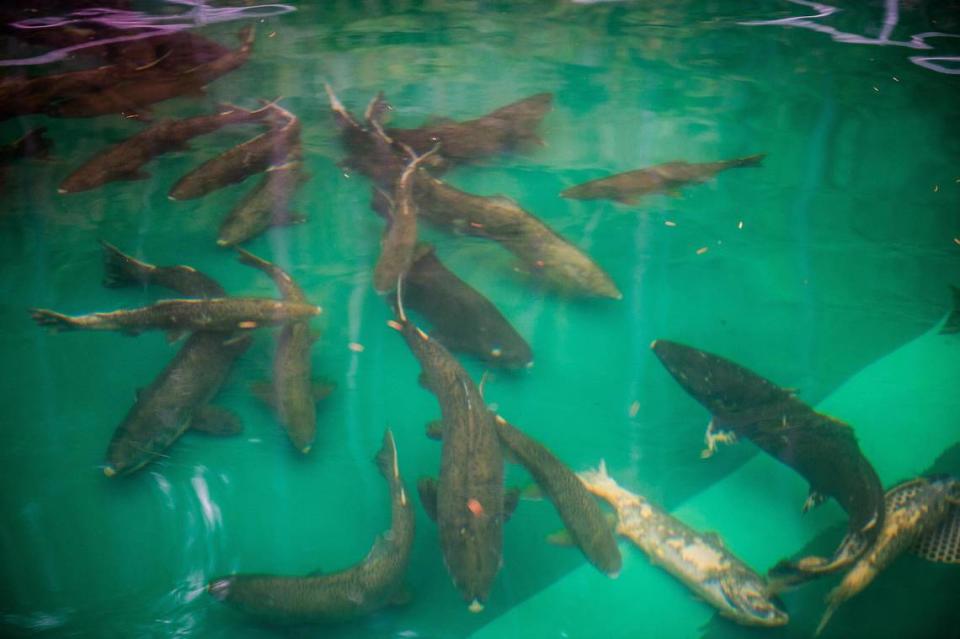President Biden orders federal agencies to make Columbia, Snake salmon a federal priority
- Oops!Something went wrong.Please try again later.
President Biden ordered federal agencies on Wednesday to prioritize restoring wild salmon and steelhead in the Columbia River Basin, including the Snake River.
It is a historic document, reflecting salmon recovery as a national priority, said the National Wildlife Federation.
Biden said he was committed to honoring the nation’s obligations to tribal nations and protecting and restoring America’s natural wonders for future generations.
But he tempered his order with language on the benefits of the river and dams, as tribes, environmental groups and professional and recreational fishing organizations have called for tearing down the four Snake River dams in Eastern Washington.
The order said it is the Biden administration’s policy not only to restore salmon, steelhead and other native fish populations, but also to continue benefits now provided by the Columbia River system and its dams.
That includes his administration’s policy to “secure a clean and resilient energy future for the region; to support local agriculture and its role in food security domestically and globally; and to invest in the communities that depend on the services provided by the basin’s federal dams ...,” the order said.

“I’m really glad President Biden and his administration are taking salmon recovery and tribal treaty rights seriously and working from every angle to restore fish populations in the Columbia River Basin, while meeting the region’s resiliency needs,” said Sen. Patty Murray, D-Wash.
But Rep. Dan Newhouse, R-Wash., said that while the order has no explicit recommendation to breach the four lower Snake River dams “that is the goal of this administration.”
“The direction from President Biden proves that his administration and dam-breaching advocates will continue to pretend to hear feedback from the community to give the perception that residents and stakeholders are being heard,” he said. “The sad truth is, this has not been a collaborative process all along and they are only seeking to accomplish one predetermined outcome — a breach of the four lower Snake River dams.”
Scott Simms, executive director of the Public Power Council, said he was glad the Biden administration “has realized the complexity of the Columbia-Snake River system and didn’t succumb to the false promises of easy solutions advanced by some single interest advocates.”
The four Snake River hydropower dams provide more than 1,000 megawatts of clean energy, or enough to power 800,000 homes.
They also make possible barging of 10% of U.S. wheat exports, plus other agriculture products that otherwise would be moved to the coast for export by trucks and rail, increasing carbon emissions, and the irrigation of farmland.
Goals in addition to saving salmon in the president’s order cannot be achieved without the dams, said Kurt Miller, executive director of Northwest RiverPartners, which represents Northwest electric utilities, plus river transportation and agriculture interests.
“The White House has discovered this is hard because we are trying to make sure that every sector is healthy, and that is really challenging,” Miller said.
What Biden order requires
The Columbia River and its tributaries, wetlands and estuaries are the lifeblood of the Pacific Northwest, the presidential order said.
“The river ecosystem has supported ways of life, cultural and spiritual practices, commerce and economic growth for generations and continues to provide our nation with abundant water, power, recreation, agriculture, transportation and opportunity,” said a White House fact sheet on the president’s order.

Since 1855, when treaties were signed with four tribal nations, the ability of tribes to exercise their rights to fish have been substantially harmed by federal dams, private dams, population growth and overfishing that have changed the ecosystem and severely depleted wild fish populations in the region, it said.
In 1855, an estimated 7.5 million to 16 million adult salmon and steelhead returned to the Columbia River Basin each year.
Now 13 salmon and steelhead species in the basin are listed as threatened or endangered.
The order directs federal agencies in the next 120 days to review their programs affecting native fish populations in the basin for consistency with Biden’s policy to honor treaty responsibilities and protect fish affected by the federal dams while also making sure other benefits continue to be available.
Within 220 days they must provide the Office of Management and Budget at the White House an assessment of their programs advancing Biden’s policy and resources needed.
They should prioritize those activities in their program and budget planning, it said.
They also have 120 days to provide the president with an update on partnerships with tribes in Washington, Oregon, Montana and Idaho.
Public input on Snake dams
Litigation in the long-running federal case over the Snake River dams has been extended 60 days to allow federal mediation to continue but community members impacted by the lawsuit are being left in the dark as negotiations take place behind closed doors, Newhouse said.
Simms said that the administration should include “full and equal participation by all stakeholders and focus on true collaborative solutions.”
The Public Power Council, which represents more than 100 consumer-owned electric utilities in the Pacific Northwest, has been focused on long-term solutions where the health of salmon and a producing hydro system are not positioned as mutually exclusive, he said.

Reliable and carbon-free generation help the Pacific Northwest confront headwinds such as “extreme climate events, new policy goals, rapid electrification and increasingly stressed grid conditions,” he said.
He also pointed out that the Bonneville Power Administration has invested more than $6.8 billion for fish and wildlife mitigation measures over the past decade.
Northwest RiverPartners also called for greater public involvement by those affected by any changes to the river system.
Miller called the White House announcement “bittersweet.”
While it recognizes the role of the lower Snake River hydroelectric dams in meeting clean energy, climate, economic and salmon recovery objects, it “builds on and extends a flawed process that has denied affected stakeholders and the public a meaningful role,” Miller said.
He also was disappointed that Biden’s memorandum ignores the 2020 environmental study on the Columbia River System, he said. It rejected calls to breach the four lower Snake River dams after considering not only benefits and risks to juvenile and adult endangered and threatened fish, but also the social and economic effects of changes to the system.
The issues of energy affordability, reliability and increasing clean energy must be central to any plan for the river system, Columbia RiverPartners said. More than 25% of the Columbia Basin region qualifies as energy burdened.
Multiple studies have shown that replacing the energy from the Lower Snake River dams would be $15 billion or more, according to Columbia RiverPartners.
Calls for removing Snake dams
But the National Wildlife Federation said Biden’s order sends a clear message throughout federal government that business as usual is no longer acceptable and that taking action is urgent.
It reflects a change from avoiding jeopardy under the Endangered Species Act to to achieving healthy and abundant populations, the federation said.

“That is a big change,” said Jacqueline Koch, communications manager for the foundation.
Plaintiffs in the federal court litigation over restoring Snake River salmon and other environmental and fishing groups applauded the president’s order.
“We need a comprehensive plan to breach the dams and replace their services — and we need it now, before salmon run out of time,” said Earthjustice Attorney Amanda Goodin.
Restoring Columbia Basin salmon runs will be a huge economic benefit to the region, said Glen Spain of the Pacific Coast Federation of Fishermen’s Associations. Even with commercial coastal salmon fisheries severely depressed, it still is a billion dollar industry supporting tens of thousands West Coast jobs, he said.
Chris Wood, president of Trout Unlimited, said while focusing the federal government on reversing the decline of wild salmon and steelhead is a welcome step, it is only a “half step” without removal of the lower Snake River dams to provide cold water habitat for native fish.
The executive director of the Idaho Wildlife Federation, Brian Brooks, said that Biden’s memorandum “finally puts us on the path toward fish abundance that provides economic, ecologic and cultural viability.”

